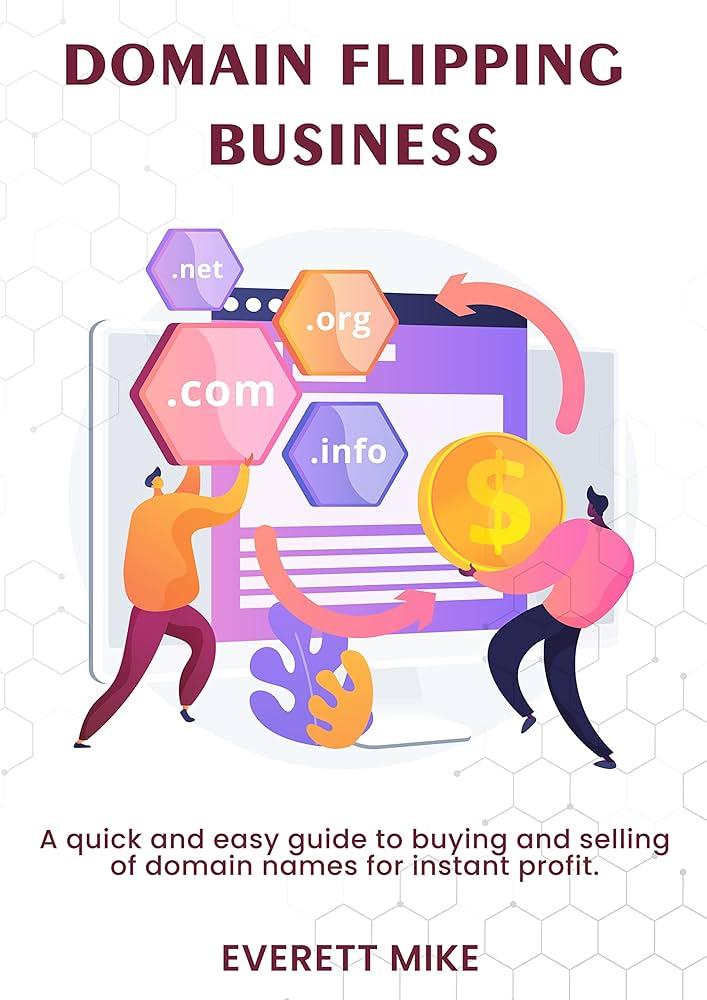Table of Contents
- Exploring the Fundamentals of Domain Flipping in Todays Marketplace
- Uncovering the Secrets to Identifying Profitable Domains
- Strategies for Effective Valuation and Pricing of Domains
- Marketing Techniques to Boost Your Domain Sales
- Building a Sustainable Business Model Around Domain Flipping
- Q&A
- Concluding Remarks
Exploring the Fundamentals of Domain Flipping in Todays Marketplace
In the world of online business, domain flipping has emerged as a lucrative opportunity for savvy entrepreneurs. By purchasing domain names at a bargain and later selling them for profit, individuals can tap into a market where the right name can hold significant value. Key factors influencing the success of domain flipping include the uniqueness of the domain, its length, and the presence of keywords that resonate with niche markets. Understanding these elements can significantly increase your chances of making profitable sales.
To navigate the domain flipping landscape effectively, consider the following strategies that can elevate your endeavors:
- Research and Analysis: Use tools like Google Trends, Domain Name Generators, and SEO research tools to identify trending keywords and popular phrases in your target niche.
- Brandability: Aim for domains that are easy to remember, spell, and pronounce. A domain that brands easily is more likely to attract buyers.
- Market Timing: Keep an eye on emerging trends and industries. Timing your sales around high-demand periods can enhance profitability significantly.
In addition to strategy, understanding the marketplace itself is crucial. Various platforms facilitate domain sales, each with its own unique offerings and audiences. Below is a comparison of popular domain marketplaces that can help streamline the selling process:
| Marketplace | Fees | Target Audience |
|---|---|---|
| GoDaddy Auctions | Varies by listing | Broad audience; beginner to experienced buyers |
| Namecheap Marketplace | 10% commission | Niche enthusiasts; budget-conscious buyers |
| Sedo | 15% commission | Global audience; businesses looking for premium domains |
By honing your skills in market analysis, choosing the right platforms, and staying attuned to consumer behaviors, domain flipping can become an essential source of revenue within the dynamic digital economy.


Uncovering the Secrets to Identifying Profitable Domains
When it comes to finding domains that can elevate your flipping game, attention to detail is your best ally. Start by analyzing keywords that resonate with current trends. Tools specifically designed for domain research can give you insights into keyword popularity and search volume. A good domain should ideally be short, memorable, and relevant to a niche market. Consider domains that incorporate local geography or trending industry phrases, as they typically attract greater buyer interest.
Another essential aspect is the domain’s history. Use tools such as the Wayback Machine to check how the domain was utilized in the past. If a domain has a rich history, it can be more appealing to potential buyers. Additionally, you should evaluate the domain’s existing backlinks using SEO tools. A domain with a strong backlink profile can give it more authority, making it easier to sell at a profitable rate. Look for domains that have been previously indexed by search engines, as these will have a higher chance of bringing in organic traffic.
Lastly, consider leveraging auctions and marketplaces where domains are bought and sold. Familiarize yourself with platforms like Flippa or Sedo, where you can find both expired domains and premium listings. Create a spreadsheet to help track data such as pricing, renewal costs, and sale history. Use a simple table format for clarity:
| Domain Name | Price | Renewal Cost | Traffic Volume |
|---|---|---|---|
| example1.com | $500 | $10/year | 300/month |
| example2.com | $1,200 | $15/year | 1,000/month |
| example3.com | $850 | $12/year | 500/month |
By strategically analyzing these factors, you can significantly increase your chances of identifying domains that will not only catch buyers’ interest but also yield great profits when flipped.


Strategies for Effective Valuation and Pricing of Domains
Valuing and pricing domains effectively requires a combination of art and science. One of the first steps in this process is conducting thorough research on the domain’s keywords. Domains that are short, memorable, and rich in relevant keywords tend to fetch higher prices. Using tools like Google Trends and various SEO software can provide insights into the domain’s potential traffic and market demand. A well-chosen domain that aligns with current trends can significantly boost its valuation.
Another crucial strategy involves analyzing comparative sales data. Websites like Sedo and NameBio offer extensive databases of previous domain sales, providing invaluable benchmarks for setting your pricing. Consider factors such as the domain’s length, age, and TLD (top-level domain) when comparing. You can compile the data in a simple table to facilitate your analysis:
| Domain Name | Sale Price | Length | TLD | Purchase Date |
|---|---|---|---|---|
| TechGiant.com | $500,000 | 9 | .com | 2023-05-01 |
| HealthyLife.org | $200,000 | 11 | .org | 2023-03-15 |
| FoodieBuzz.net | $150,000 | 11 | .net | 2022-11-07 |
Lastly, understanding your target buyer is key in formulating a competitive pricing strategy. Knowing whether you are marketing to a startup company, an individual, or a large corporation can significantly impact how you position the domain. Create a profile of potential buyers and tailor your pitch accordingly. Emphasizing the domain’s unique selling points—such as brandability, SEO benefits, and market relevance—can enhance its appeal. Engage with potential buyers through emails, social media, and domain marketplaces, providing them with compelling reasons to invest in your domain at the price you’ve set.


Marketing Techniques to Boost Your Domain Sales
To effectively sell domains, leveraging digital marketing strategies is crucial. Start by building a strong online presence through various platforms. Utilize social media channels to showcase your domain portfolio. Engage with relevant communities and groups dedicated to domain investment and flipping. Consider creating informative content about domain trends or success stories to establish authority. Networking in these spaces can lead to potential buyers who appreciate well-researched domains.
Another powerful marketing technique is utilizing pay-per-click (PPC) advertising. This approach allows you to target potential buyers efficiently. Create enticing ad copies that highlight the unique value of your domains. Focus on specific keywords relevant to your target audience, and make sure to direct them to a well-designed landing page featuring your domains. You can also test different ad formats across platforms to determine what resonates best with your desired market.
Lastly, email marketing remains a potent tool for connecting with potential buyers. Create a subscriber list by offering valuable insights, like tips on domain investment, to attract interested users. Use persuasive email campaigns, featuring exclusive offers and new acquisition announcements, to keep your audience engaged. Consider segmenting your list based on the interests and behaviors of your subscribers for more tailored messaging.


Building a Sustainable Business Model Around Domain Flipping
When diving into domain flipping, the key to longevity and success lies in establishing a sustainable business model that stands the test of time. Start by identifying your niche within the vast world of domain names. This could range from specific industries, popular trends, or even geographical domains. By focusing on a niche, you’re better positioned to understand market demands and customer needs, making it easier to acquire domains that offer potential for resale. Consider the following aspects when choosing your niche:
- Market Research: Analyze current trends and popular industries.
- Domain Value: Look for domains that are short, memorable, and relevant.
- Competitive Analysis: Identify competitors and their domain strategies.
Once a niche is chosen, the next step is to build a diverse portfolio. A well-rounded collection not only maximizes profit potential but also mitigates risks associated with domain flipping. Diversification allows you to sell domains at different price points and target a broader audience. Keep in mind the importance of quality over quantity; selectively purchase domains that align with your business goals. Here’s a quick overview of how to categorize your domains for an efficient portfolio:
| Category | Description | Target Audience |
|---|---|---|
| Premium Domains | Short, keyword-rich names with high market demand. | Businesses and startups. |
| Brandable Domains | Creative names that can easily be turned into brands. | Entrepreneurs and marketers. |
| Geo-Domains | Location-based names that attract local businesses. | Real estate and local services. |
focus on marketing and networking to elevate your flipping endeavors. Building relationships with potential buyers, participating in domain forums, and leveraging social media channels can significantly enhance your visibility in the market. Share your success stories, provide insights, and engage with others in the community. Use strategies such as:
- Content Marketing: Create blog posts about domain trends and flipping tips.
- Email Campaigns: Reach out to your audience with curated domain offerings.
- Social Media Presence: Showcase your portfolio and engage with customers directly.
Q&A
Q&A: Domain Flipping by the Millionaire Society
Q1: What is domain flipping, and how does it work? A1: Domain flipping is the practice of buying domain names at a low price and selling them at a higher price for profit. It typically involves identifying valuable or trending domain names that could appeal to businesses or individuals seeking an online presence. The process begins with purchasing a domain, enhancing its value through marketing or SEO optimization, and selling it through various online marketplaces or auctions.Q2: Why has domain flipping become popular among entrepreneurs? A2: The allure of domain flipping lies in its potential for high returns with relatively low initial investment. With the increasing importance of online branding and presence, high-quality domain names are sought after more than ever. Entrepreneurs see it as a scalable business model that can generate significant revenue with the right strategies and market insights.
Q3: What does “The Millionaire Society” refer to in the context of domain flipping? A3: “The Millionaire Society” is a term used to describe a group of successful individuals who have mastered the art of domain flipping. They share insights, strategies, and resources to help aspiring domain flippers navigate the complexities of the domain market. Being part of such a society often means having access to exclusive information and mentoring that can significantly enhance one’s flipping success.
Q4: What strategies do successful domain flippers use to identify valuable domains? A4: Experienced domain flippers typically employ several strategies, such as conducting keyword research to pinpoint popular search terms, analyzing industry trends to find emerging niches, and using domain appraisal tools to estimate market value. They also consider factors like domain length, memorability, and the use of popular extensions (.com, .net, etc.) to optimize their buying decisions.
Q5: Is it safe to invest in domain flipping? A5: Like any investment, domain flipping carries risks. The market can be unpredictable, and not all domains sell for a profit. However, conducting thorough research, staying updated on market trends, and understanding valuation can minimize risks. It’s essential to approach domain flipping as a business, with clear strategies for buying, holding, and selling, to enhance safety and profitability.
Q6: What resources are recommended for newcomers to domain flipping? A6: Newcomers can benefit from online forums, blogs, and courses dedicated to domain flipping. Websites like NamePros and Flippa offer insights and marketplaces, while SEO tools like SEMrush and Moz can assist in keyword research. Joining communities such as “The Millionaire Society” can provide mentorship and support, making the learning curve more manageable.
Q7: How much capital do I need to start flipping domains? A7: You can start domain flipping with a few hundred dollars. The entry cost typically involves purchasing domain names, which can range from as little as $10 to several thousands, depending on the perceived value. Starting small and reinvesting profits back into purchasing more valuable domains is a common approach.
Q8: What are the common pitfalls to avoid when flipping domains? A8: Common pitfalls include overestimating the value of a domain, neglecting the importance of quality over quantity, and failing to research the market thoroughly. Many newcomers also overlook the costs associated with renewing domains or listing fees on marketplaces. It’s crucial to develop a disciplined strategy to avoid these mistakes.
Q9: Can domain flipping be a full-time career? A9: Yes, for those who dedicate themselves to mastering the market, domain flipping can turn into a full-time career. Success in this field often requires a significant time investment in research, networking, and marketing. Many successful flippers view it as an entrepreneurial venture rather than just a side hustle.
Q10: What is the future of domain flipping? A10: As the online landscape continues to evolve, domain flipping is likely to remain a viable business model. The increasing reliance on digital marketing and e-commerce suggests that demand for quality domains will persist. However, competition will intensify, making innovation and strategic planning crucial for those looking to thrive in this space.

